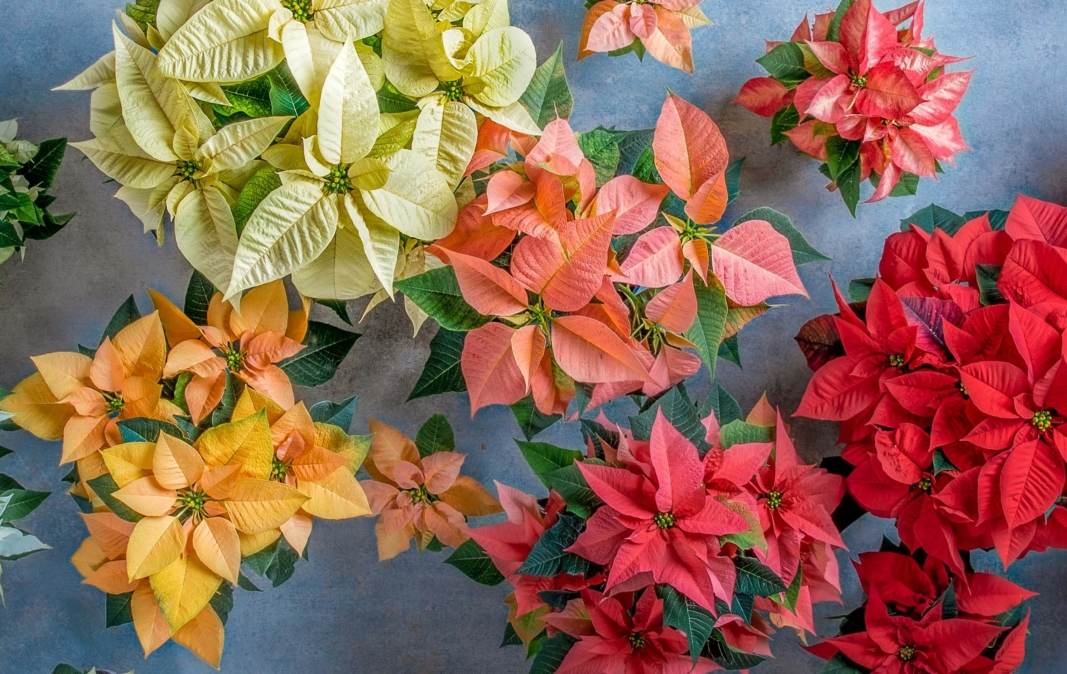 Bryn Wallace
Bryn WallacePoinsettia Care Guide
Available in a wide range of colors from red to white to pink and even bright orange, poinsettias are a great way to bring some festive color to your home to enjoy throughout the holiday season. Native to Central and South Mexico, poinsettias prefer temperatures between 60 and 70 degrees but will tolerate temperatures slightly higher or lower than this range. This makes them an ideal plant for indoors when provided with the right amount of consistent moisture and light. We’ve assembled a guide for Poinsettia selection and care to help you keep your poinsettias healthy through the holidays and beyond.
How to Select Your Poinsettia
When selecting your poinsettia, there are a few qualities you can check for to ensure that you are taking home a plant in ideal health. Poinsettia leaves should be a nice, dark green shade without any yellowing or browning or crispy edges. The bracts (the colorful leaves) should be vibrant and free from browning or yellowing. The buds at the center of the bracts should be tight. The tighter the bud, the longer the plant will last. The best poinsettias will be two and a half times the pot height and have sturdy, stable stems. Once you pick out your favorite poinsettia, Merrifield will put either a paper or plastic sleeve over the plant to protect it from cold temperatures, snow and ice, depending on when you purchase your plant. When you get home, bring your poinsettia inside immediately so that it is not left in a cold vehicle, and make sure you take the sleeve off carefully to avoid damaging the leaves or bracts. Do not leave the sleeve on the plant for more than 24 hours.
Finding the Best Location for Your Poinsettia
When you get home from the garden center with your new poinsettia plant, it’s time to figure out where to best keep it throughout the winter season. We recommend keeping your plant inside, as this time of year in Northern Virginia is much too cold to keep the plant outside. As it is from Mexico, it thrives in warmer climates and will suffer when left out in temperatures below 60 degrees. When indoors, poinsettias prefer bright, indirect light in an east or west facing window or on a coffee table near a West facing window, but not directly in the intense sunlight. Even though it prefers to be warmer, you should not place your poinsettia where the leaves will wilt and become crispy because of excessive hot and dry air, for instance by radiators and drafts and on mantels above fireplaces.
Note for placing Poinsettias: These plants are mildly toxic to pets, so it would be best to place your poinsettias in areas where your furry friends are less likely to feed off of the plant.
Check Your Plant Daily and Water Regularly
Poinsettias should be consistently moist to the touch, but never sitting in water. Check on your plant periodically to see if the soil is dry. If the top 1 inch of soil is dry to the touch, it is time to water your poinsettia. The more light it receives, the more often it must be watered. If it’s in a bright, sunny window that gets light for most of the day, you will find yourself needing to water your poinsettia more. When you are watering your poinsettia thoroughly, make sure that it drains out well to avoid root rot. There is no need to fertilize your plant if you plan only to keep it through the winter, but if you choose to keep it through the rest of the year, you can begin to fertilize every three or four weeks after the holidays.
Care After the Poinsettia Bloom Cycle
As the poinsettia finishes its bloom cycle, you will see the buds and bracts begin to fall off the plant. At this point, you will be left with a green plant that you can maintain as a regular houseplant, if you wish. Poinsettias should be kept in either bright indirect light or full sun. In order to get them reblooming next year, you will need to induce a dormant resting period for the plant. To achieve this, it will need 6 weeks of 14 to 16 hours of absolute darkness, either in a closet, a box or an unused room in your home. During these times, keep it away from all artificial light, including from street lamps outside your window. Repotting your poinsettia is usually done in spring, if you need to place it in a larger pot.



